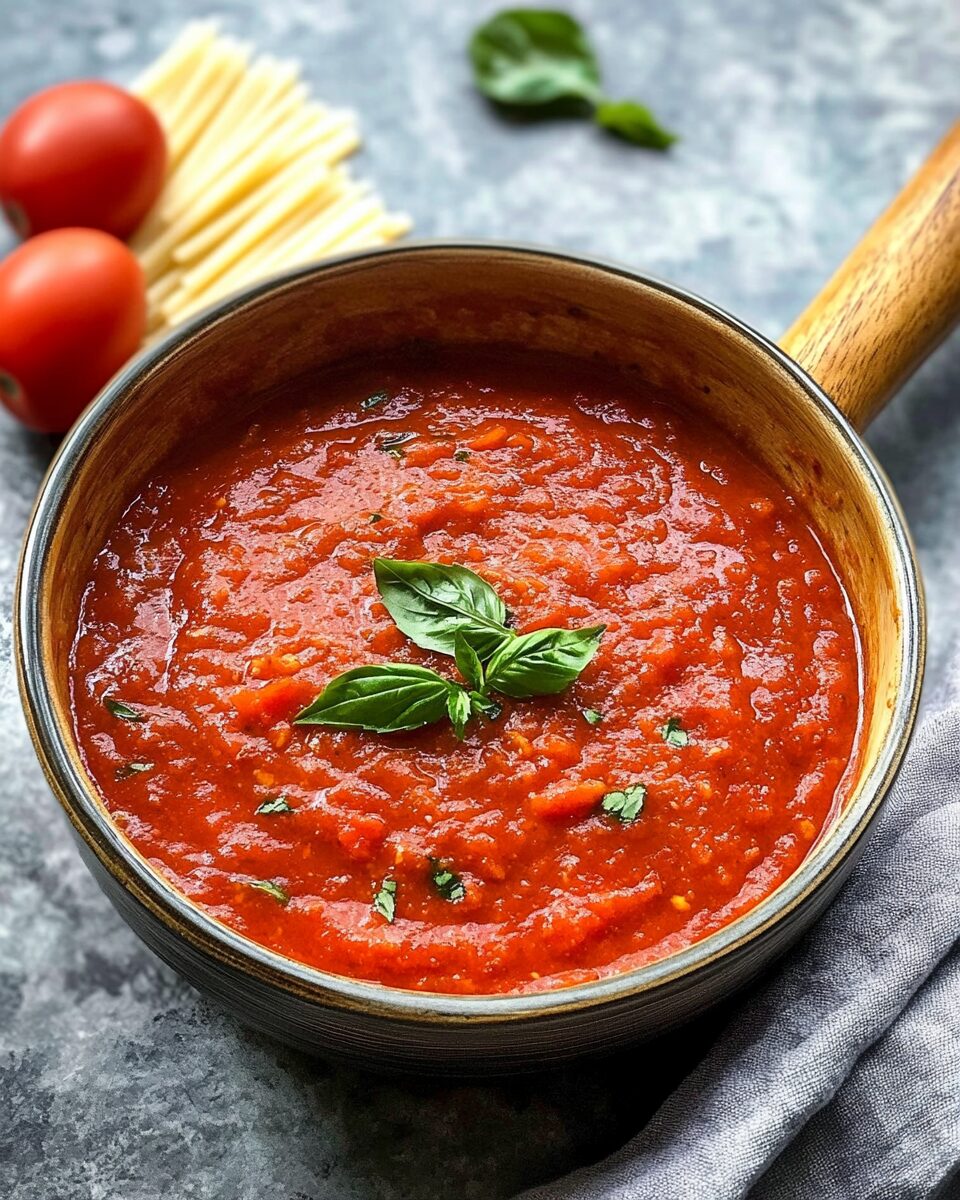A good homemade tomato sauce can transform any meal into something special. Made with ripe tomatoes, aromatic garlic, and fragrant herbs, this sauce boasts deep, authentic Italian flavors. Slow simmering enhances the natural sweetness of the tomatoes, creating a smooth, velvety texture that clings perfectly to pasta or pizza crust.
Versatile and easy to make, this sauce is the perfect foundation for countless dishes, from classic spaghetti to hearty lasagnas. Whether you prefer a chunky, rustic texture or a silky-smooth consistency, this recipe can be adapted to suit your taste. A touch of fresh basil and Parmesan at the end brings everything together, making it a staple for every home cook.
Full Recipe:
Ingredients:
- 2 tablespoons olive oil
- 1 small onion, finely chopped
- 3 cloves garlic, minced
- 1 can (28 oz) crushed tomatoes
- 1 can (14 oz) diced tomatoes
- 1 tablespoon tomato paste
- 1 teaspoon dried oregano
- 1 teaspoon dried basil
- 1/2 teaspoon red pepper flakes (optional)
- 1 teaspoon sugar (optional, to balance acidity)
- Salt and black pepper, to taste
- 1/2 cup fresh basil leaves, torn
- 1/4 cup grated Parmesan cheese (optional)
Directions:
- Heat olive oil in a large saucepan over medium heat.
- Add the chopped onion and sauté for 3-4 minutes until soft and translucent.
- Stir in the minced garlic and cook for another 30 seconds until fragrant.
- Pour in the crushed and diced tomatoes, then add the tomato paste. Stir well to combine.
- Season with dried oregano, dried basil, red pepper flakes, sugar, salt, and black pepper.
- Bring to a gentle simmer, reduce the heat, and let it cook uncovered for 30-40 minutes, stirring occasionally.
- Stir in fresh basil leaves and Parmesan cheese (if using) during the last 5 minutes of cooking.
- Taste and adjust seasoning if needed.
- Serve warm over pasta, as a pizza sauce, or as a base for other Italian dishes.
Prep Time: 10 minutes | Cooking Time: 40 minutes | Total Time: 50 minutes
Kcal: 120 kcal per serving | Servings: 6
The Ultimate Guide to Classic Homemade Tomato Sauce
A rich and velvety homemade tomato sauce is a staple in any kitchen. Whether you are preparing a quick weeknight pasta dish, crafting a homemade pizza, or making a comforting lasagna, this sauce is the key to bringing deep and robust flavors to your meals. Unlike store-bought sauces, which often contain preservatives, excessive sugar, and artificial flavor enhancers, a homemade version is fresh, customizable, and packed with wholesome ingredients.
This classic Italian tomato sauce is made using simple ingredients like tomatoes, onions, garlic, and herbs. The magic happens when everything is slowly simmered, allowing the flavors to meld together beautifully. The best part? Once you master this recipe, you can tweak it to suit your personal preferences, making it spicier, sweeter, or richer.
The History of Tomato Sauce in Italian Cuisine
Tomato sauce has deep roots in Italian cooking, dating back to the 16th century. Although tomatoes originated in South America, they were introduced to Europe through Spanish explorers and eventually found their way into Italian cuisine. Initially, tomatoes were viewed with skepticism, as they belonged to the nightshade family and were mistakenly thought to be toxic. However, by the 18th century, they became widely used in Neapolitan cooking.
One of the earliest written recipes for tomato sauce appeared in Antonio Latini’s 1692 cookbook, Lo Scalco alla Moderna (The Modern Steward). This early version of tomato sauce laid the foundation for the various styles we know today, including marinara, pomodoro, and bolognese sauces. Today, tomato sauce is a defining element of Italian and Mediterranean cuisine, loved for its versatility and rich flavor.
Why Homemade Tomato Sauce is Better Than Store-Bought
With the convenience of pre-made sauces available in every grocery store, you might wonder why making your own tomato sauce is worth the effort. Here are some compelling reasons why homemade is always better:
- No Preservatives or Artificial Ingredients – Most store-bought tomato sauces contain stabilizers, preservatives, and excessive sodium to extend shelf life. When making your own sauce, you have complete control over what goes in.
- Customizable Flavors – Homemade sauce allows you to adjust the seasonings, sweetness, and texture to your liking. Whether you prefer a chunky sauce or a smooth, blended one, you get to decide.
- Better Nutritional Value – By using fresh tomatoes and natural ingredients, you maximize the health benefits of lycopene, an antioxidant found in tomatoes that is linked to heart health.
- More Economical – Making your own sauce is cost-effective, especially if you use seasonal or homegrown tomatoes. Plus, you can make a large batch and store it for later use.
Types of Tomatoes to Use for the Best Sauce
The type of tomatoes you use will impact the flavor, texture, and richness of your sauce. Some of the best varieties for tomato sauce include:
- San Marzano Tomatoes – These Italian-grown tomatoes are widely considered the gold standard for making sauce. They are naturally sweet, low in acidity, and have fewer seeds.
- Roma Tomatoes – Also known as plum tomatoes, these are readily available and offer a great balance of sweetness and acidity. They are meatier than other varieties, making them ideal for sauce.
- Heirloom Tomatoes – These tomatoes provide a complex and fresh flavor, though they tend to be more watery. If using heirloom tomatoes, it’s best to cook the sauce longer to reduce excess liquid.
- Canned Tomatoes – If fresh tomatoes are out of season, high-quality canned tomatoes can be a great alternative. Look for San Marzano D.O.P. certified canned tomatoes for the most authentic taste.
Tips for Achieving the Perfect Tomato Sauce
Making a flavorful homemade tomato sauce is an art, and a few small tweaks can take it from good to restaurant-quality. Here are some expert tips for getting the best results:
- Use Fresh Ingredients – The best tomato sauce starts with high-quality ingredients. Fresh onions, garlic, and basil will give your sauce a natural, aromatic depth.
- Don’t Skip the Simmering Time – The longer your sauce simmers, the more the flavors develop. Let it cook for at least 30-40 minutes to enhance richness.
- Balance Acidity with a Touch of Sweetness – Some tomatoes can be naturally acidic. Adding a small amount of sugar, honey, or even a finely grated carrot can neutralize acidity without making the sauce overly sweet.
- Layer the Flavors – Start by sautéing onions and garlic in olive oil before adding tomatoes. This step builds depth and ensures that the aromatics infuse into the sauce.
- Use a Splash of Red Wine – For an extra layer of richness, deglaze the pan with a bit of red wine before adding the tomatoes. This step enhances complexity and brings out the sauce’s natural sweetness.
- Blend for a Smooth Texture – If you prefer a silky, smooth sauce, use an immersion blender or food processor to puree the sauce before serving. For a chunky, rustic sauce, leave it as is.
- Store for Later – This sauce freezes well! Let it cool completely before transferring to airtight containers or freezer bags. It can be stored in the fridge for up to 5 days or in the freezer for 3 months.
How to Use Your Tomato Sauce
Once you have a batch of homemade tomato sauce, the possibilities are endless. Here are some delicious ways to use it in your cooking:
- Classic Spaghetti or Pasta – Toss your sauce with al dente pasta, top with grated Parmesan cheese, and enjoy a comforting meal.
- Homemade Pizza Sauce – Spread it over a pizza crust and add your favorite toppings for a homemade pizza night.
- Lasagna Filling – Layer it between pasta sheets, ricotta cheese, and mozzarella for a classic Italian lasagna.
- Meatball Marinara – Serve over homemade meatballs for a hearty dish.
- Eggplant Parmesan – Use it as a base for baked Eggplant Parmesan, a crispy and cheesy Italian favorite.
- Dipping Sauce – Serve as a dipping sauce for mozzarella sticks, garlic bread, or even grilled cheese sandwiches.
Conclusion: A Staple Recipe for Every Kitchen
Homemade tomato sauce is more than just a pantry staple; it’s a foundation for creating comforting, delicious meals that bring people together. With just a handful of fresh ingredients, a little patience, and a few cooking techniques, you can achieve a sauce that rivals any restaurant-quality dish.
The beauty of this recipe lies in its simplicity and versatility. Whether you’re a beginner in the kitchen or an experienced home cook, mastering homemade tomato sauce allows you to create dishes packed with rich flavors and wholesome goodness. Plus, making your own sauce means you can enjoy a meal that is free of preservatives, lower in sodium, and tailored to your personal preferences.
So the next time you’re reaching for a jar of store-bought tomato sauce, remember—a homemade version is always worth it. With a little effort and the right ingredients, you’ll have a flavorful, authentic sauce that will elevate your Italian-inspired dishes to a whole new level.






